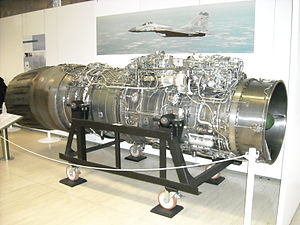Klimov RD-33
| RD-33 | |
|---|---|
 |
|
| RD-33 on display at the Luftwaffe Museum | |
| Type | Turbofan |
| Manufacturer | Klimov |
| First run | 1974 |
| Major applications |
Mikoyan MiG-29 Mikoyan MiG-35 Dassault Mirage F1 CAC/PAC JF-17 Thunder |
The Klimov RD-33 is a turbofan jet engine for a lightweight fighter jet that is the primary engine for the Mikoyan MiG-29 and CAC/PAC JF-17 Thunder. It was developed in OKB-117 led by S. P. Izotov (now OAO Klimov) from 1968 with production starting in 1981. Previous generations of Russian supersonic fighters such as the MiG-21 and MiG-27 used turbojets, but western fighters such as the F-111 and F-4K introduced the use of afterburning turbofans in the 1960s which were more efficient. The RD-33 was the first afterburning turbofan engine produced by the Klimov company of Russia in the 8,000 to 9,000 kilograms-force (78,000 to 88,000 N; 18,000 to 20,000 lbf) thrust class. It features a modular twin-shaft design with individual parts that can be replaced separately and has a good tolerance to the environment. The RD-33 is simple to maintain and retains good performance in challenging environments.
In early 1970s the RD-33 was selected for new light fighter jet, later becoming Mikoyan MiG-29, the other option was Tumansky R-67-300. Years of development has built an extensive engine family. A newly designed thrust vectoring nozzle (TVN) is now available. New models of the RD-33 family include BARK digital monitoring and control systems. Repair and maintenance of RD-33 engines takes advantage of an information and diagnostics system (IDS).
Baseline model developed in 1976 to power the MiG-29.
A model without afterburner for various types of aircraft, such as the Il-102.
A variant used to power the JF-17 (FC-1). According to JF-17.com "The most significant difference being the repositioning of the gearbox along the bottom of the engine casing." The Klimov poster at Zhuhai 2010 airshow gave the thrust range of the engine to be 79 kN Dry to 98 kN Wet. This was designed specifically for FC-1 with increased thrust and relocated gearbox compared to base RD-33's. Although the increase of thrust decreased the service life of RD-93 to 2200 hours from RD-33's 4000 hours. According to Air Commodore Mehmood engines are solid and reliable: “We’ve flown 7,000 hours with the engine and we haven’t had any problems”, he said
...
Wikipedia
